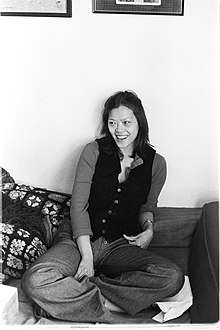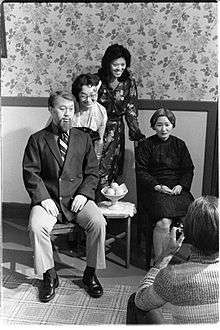Kathy Change
Kathleen Chang (October 10, 1950 – October 22, 1996), known by her performance name Kathy Change, was a Chinese-American political activist, writer, and performance artist. She was a familiar figure on the University of Pennsylvania campus, often dancing on the College Green brandishing homemade flags painted with various political messages and vocally advocating nonviolent social revolution.[1] On October 22, 1996, she committed suicide by self-immolation on the spot where she had often performed in an effort to engage Penn students in the progressive causes she championed; the packages of writings she delivered to six Penn students, two local residents, as well as Penn's campus newspaper and other news organizations contextualized her carefully planned suicide as both protest and a vehicle for her message.[2]
Kathy Change | |
|---|---|
 | |
| Born | October 10, 1950 |
| Died | October 22, 1996 (aged 46) Philadelphia, Pennsylvania |
| Cause of death | Burns from self-immolation |
| Other names | Kathleen Chang |
| Spouse(s) | |
| Website | Official website |
She changed her performance name to Kathy Change to indicate her commitment to political and social change. She was the daughter of Chinese academics who emigrated to America in the wake of the Chinese Revolution. Change was married to writer Frank Chin for five years.
Life
Change was born Kathleen Chang in Ohio in 1950. Her father, Sheldon Chang, was an engineer and a professor at the State University at Stony Brook, Long Island, New York. Her mother Gertrude (née Hung) was a writer. Her mother's father, William Hung, was one of the founders of Yenching University and later taught at Harvard. She had one brother. Her parents divorced while she was a teenager, leading to Chang's first suicide attempt. Her mother committed suicide when Kathy was 14 years old.[3]
Change graduated from the Bronx High School of Science in New York City and briefly attended Mills College and the Bronx campus of New York University. After she married Frank Chin in 1971, she returned to California. Her marriage lasted five years, and she attempted suicide again after it ended.[3]
.jpg)
In 1977, she wrote and illustrated a 24-page children's book, The Iron Moonhunter. The book purportedly retells a legend handed down by Chinese workers of the Central Pacific Railroad working on the First Transcontinental Railroad in the 19th century; the titular train was built using salvaged steel to rescue the restless spirits of workers who had died during construction in harsh mountain conditions.[3][4][5]
In 1981, Change moved to Philadelphia. Around this time, her life became increasingly defined by her political activism and by what many observers would term mental illness. The New York Times noted that she had seen psychiatrists off and on for her adult life, although friends were unaware if a specific illness had been diagnosed.[3] For a brief period in the early 1980s, she squatted in an abandoned Philadelphia building with others in the Powelton Village neighborhood on the edge of Drexel University campus. She also for awhile lived nearby on Spring Garden Street.
Around this time, she added an "e" to her last name, and informally changed her name to Kathy Change.[5] By 1996, she had legally adopted the name Change.[2]
Activism
Change was drawn to political activism for diverse causes for most of her adult life. In 1990, she was named "Freedom Fighter of the Month" by High Times magazine, recognizing her activism for cannabis legalization.[3] For 15 years she gave colorful one-woman street performances on Penn's campus and around Philadelphia to protest the government, during which she danced, sang, played the guitar and electronic keyboard, waved handmade flags, and made speeches.[6][7] These performances included a weekly presentation on Sunday afternoons at the Philadelphia Museum of Art. In the final years of her Art Museum performances, she was joined by singer/songwriter David Downing, who wrote "Stop the Business (Transformation Day)," an anthem for her political movement.
Change founded and led the Transformation Party, a political party that advocated a complete change of the government and society.[7] An "emergency economy" would be created by workers in essential industries, which would allow the majority of citizens to form a more representative democracy.[6]
Death
I've tried to do this several times before,
And failed.
If this is the right thing to do,
Heaven help me.
If not,
Well,
Never mind. I'll be seeing you around.— Kathy Change, "A Note to Sympathetic Penn Students," October 1996.[5]
At 11:20 am, October 22, Change doused herself with gasoline in front of Peace Symbol, a stainless steel sculpture (Robert Engman, 1967; installed 1983) west of the Van Pelt Library and set herself on fire.[2][8] Flames shot ten feet in the air as she danced in front of approximately fifty onlookers.[5] Penn Police officer Bill Dailey tried to put out the flames with his jacket and was subsequently honored at a 1997 ceremony held by the school's Division of Public Safety, for attempting to prevent Change's suicide. A speech given at the event cited Dailey's "heroism under emotionally stressful and physically dangerous circumstances". After he noticed the flames from a distance and determined that a person was on fire, he attempted to extinguish the conflagration by wrapping her in his patrol jacket and rolling her on the ground.[9] The flames restarted several times.[7]
She was taken to the Hospital of the University of Pennsylvania with burns over 100% of her body. Change was pronounced dead at 11:48 am.[2][5]
Rationale
In a packet of her writings that she delivered to The Philadelphia Inquirer, the Daily Pennsylvanian, and several friends and acquaintances (six students and two local citizens) on the morning of her death,[2] she explained the rationale behind her suicide:
I want to protest the present government and economic system and the cynicism and passivity of the people ... as emphatically as I can. But primarily, I want to get publicity in order to draw attention to my proposal for immediate social transformation. To do this I plan to end my own life. The attention of the media is only caught by acts of violence. My moral principles prevent me from doing harm to anyone else or their property, so I must perform this act of violence against myself. ... It is a waste of energy to get angry and gripe at the government. The government must be replaced with a truly democratic self-government of, for and by the people. Those working in industries essential to maintaining life should democratically take over their workplaces and organize an emergency economy to supply the needs of the people. The rest of the people should meet in their communities to organize a new directly democratic community-based self-government.
Change felt that she "need[ed] to do something sensational that will make headline news and people will have to stop and talk about me and the message that I'm trying to put out."[7]
Legacy
A memorial is held in her honor every year on October 22 at the peace sign sculpture on the University of Pennsylvania campus where Kathy died. The memorial attracts artists, activists and performers, among others.[10]
Percussionist/composer Kevin Norton wrote a suite for Kathy Change entitled Change Dance (Troubled Energy) in 2001 and was released late in 2001/early 2002 on the Barking Hoop label.[11][12]
Drummer Tyshawn Sorey composed and performed "For Kathy Change," a quintet in her honor, in March 2011.[13]
Soomi Kim wrote and performed in the biographical play "Chang(e)", directed by Suzi Takahashi, which premiered in 2013 and has had multiple performances since then,[14][15] including New York City[16] and Portland, Oregon.[17]
Pulitzer Prize-winning playwright Quiara Alegría Hudes's 2016 play "Daphne's Dive," based in Philadelphia, features a character closely resembling Kathy Change.[18][19] The play is dedicated "in memory: Kathy Chang(e)."[20]
Actor (and writer) Shin-Fei Chen portrays "Peace Activist Kathy Change" in Andrew Repasky McElhinney’s forthcoming movie, Casual Encounters: Philadelphia True Crime Confessions. Her scenes were shot on 35mm Kodak film, September 2018 in West Philadelphia.
Industrial metal band Fear Factory wrote the song "Slave Labor" referring to her suicide.
See also
- Bruce Lee and Theresa Hak Kyung Cha, subjects of prior work by Soomi Kim
References
- Shahadi, Joseph (Summer 2011). "Burn: The Radical Disappearance of Kathy Change". The Drama Review. 55: 55. doi:10.1162/DRAM_a_00070.
- Hammer, Ben (23 October 1996). "Local activist kills herself on College Green" (PDF). The Daily Pennsylvanian. CXII (94). Retrieved 6 June 2018.
- Fisher, Ian (November 27, 1996). "The Manic and Messianic Life of a Troubled Idealist". The New York Times. Retrieved March 27, 2011.
- "The Iron Moonhunter (product page)". Amazon.com. Retrieved March 29, 2011.
- Tony, Mike (April 30, 2014). "Kathy Change legacy burns on". The Daily Pennsylvanian. Archived from the original on 3 May 2014. Retrieved 5 June 2018.
- Albers, Suzanne (23 October 1996). "Change's ideas called for a 'transformation'" (PDF). The Daily Pennsylvanian. CXII (94). Retrieved 6 June 2018.
- Fisher, Ian (24 October 1996). "Woman's Life of Protesting Ends in a Suicide of Flames". The New York Times. Retrieved 6 June 2018.
- Nark, Jason (23 October 2016). "Activist Kathy Chang, who set herself afire 20 years ago, remembered at Penn". The Philadelphia Inquirer. Retrieved 5 June 2018.
- Burke, Shannon (May 16, 1997). "Public Safety honors top cops with Houston Hall ceremony". The Daily Pennsylvanian. Retrieved 6 June 2018.
- "Yearly memorial". Archived from the original on 17 February 2015. Retrieved March 22, 2011.
- "Kevin Norton: Change Dance - troubled energy". Allaboutjazz.com. Retrieved 2014-02-19.
- Steinberg, Aaron. "Jazz Departments: Kevin Norton - By Aaron Steinberg — Jazz Articles". Jazztimes.com. Archived from the original on 2015-11-25. Retrieved 2014-02-19.
- "Tyshawn Sorey's For Kathy Change". Ars Nova Workshop: Jazz and Experimental Music. 11 March 2011. Retrieved March 22, 2011.
- "Hemispheric New York Events". Hemispheric Institute Centers. October 2013. Retrieved 5 June 2018.
- Crimmins, Peter (7 October 2014). "Salute to activist's quest for change sheds light on woman once a fixture on Penn campus [photos]". WHYY. Retrieved 5 June 2018.
- Collins-Hughes, Laura (8 November 2015). "Review: 'Chang(e)' Explores a Woman's Self-Immolation". The New York Times. Retrieved 6 June 2018.
- Whelan, Elizabeth (12 December 2017). "Boom Arts: A dance for freedom". Oregon Artswatch. Retrieved 6 June 2018.
- Isherwood, Charles (15 May 2016). "Review: 'Daphne's Dive,' Where Everybody Knows You're Broke". The New York Times. Retrieved 10 June 2018.
- Mukherjee, Arpita (17 May 2016). "Review: Daphne's Dive". StageBuddy: The Insiders Guide to Theater. Retrieved 10 June 2018.
- Hudes, Quiara Alegría (2017). Daphne's Dive (PDF). Dramatists Play Service. ISBN 978-0-8222-3610-8. Retrieved 10 June 2018.
| Wikimedia Commons has media related to Kathy Change. |
External links
- The Official Website http://www.kathychange.org
- Philadelphia Weekly piece about the 10-year memorial event for Change
- Theatrical performance about the political transformation of Kathy Change
- Philadelphia Inquirer piece about the 20-year memorial event for Change
- Excerpts from October 1996 packet of writings
- Chang(e), by Soomi Kim and Suzi Takahashi
- Anthony Campuzano, Portrait of Kathy Change (2004)
- Andrés Castro, The Peace Sculpture Wore (1996), a poem dated to 1996


